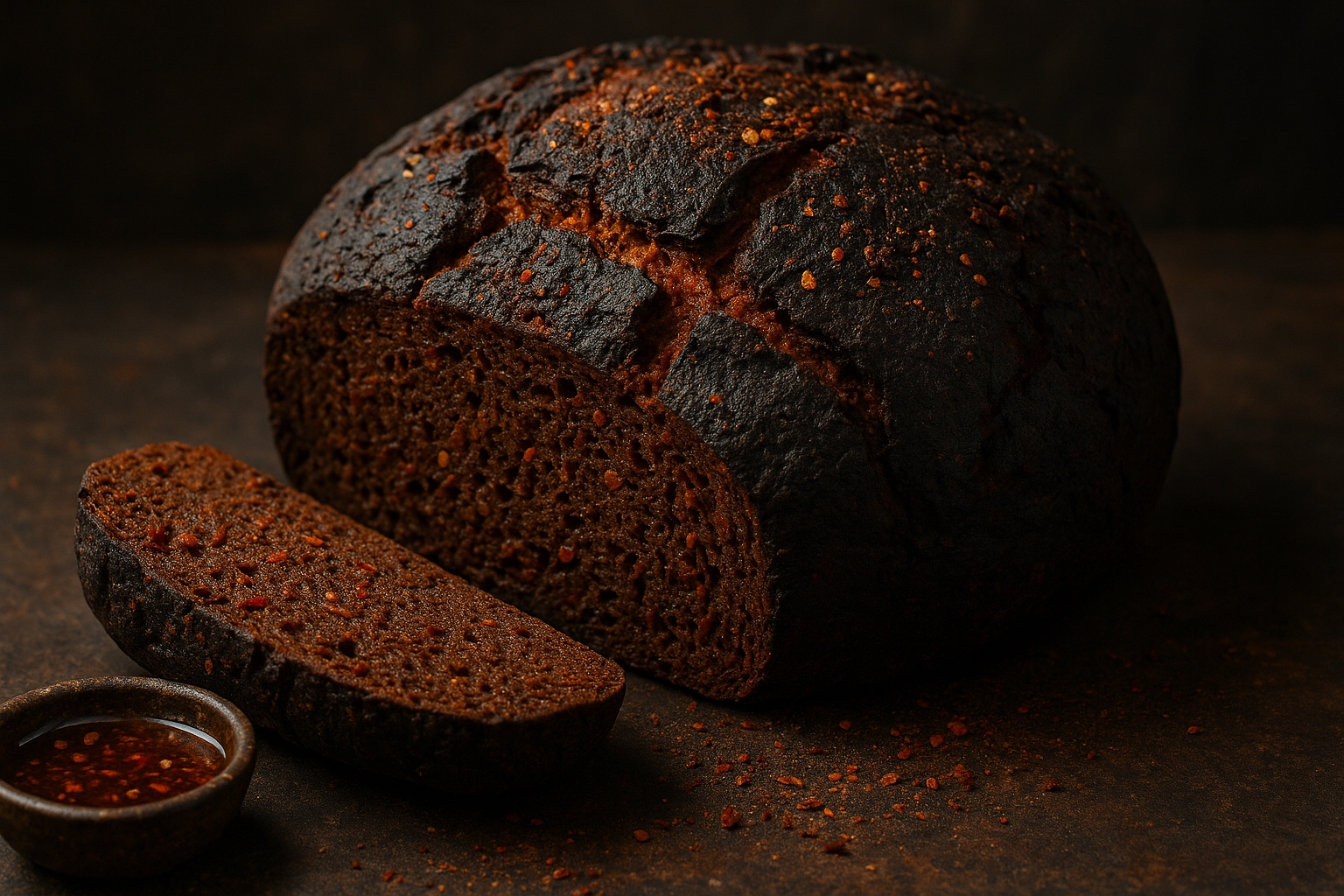Stonefire Bread
“Hard as stone, hot as forge-fire, hearty as a dwarven oath.”Stonefire Bread is a cornerstone of dwarven cuisine across the deepholds, forge-cities, and underground bastions of Domen Aria. Found on every dwarven dinner table, from noble halls to mining outposts, it is more than mere sustenance, it is a symbol of dwarven endurance, craftsmanship, and cultural pride.
Appearance & Texture
Stonefire Bread is a compact, round or brick-shaped loaf, often marked with shallow chisel-like scoring along the top crust, which cracks during baking to form fissures resembling volcanic stone. Its exterior is dark, nearly blackened, with streaks of red-gold from the searing heat used to bake it. Inside, it’s dense, chewy, and slightly oily, with a deep brown-umber hue. The bread holds pockets of concentrated spice that can surprise unwary eaters with bursts of fiery heat.Taste & Aroma
The bread is pungent and aromatic, with heavy notes of smoked cavern herbs, fireroot, and deep-spice peppers cultivated in subterranean fungal beds. While dwarves savor the strong, heated flavor as a comfort, most humans find it overwhelmingly spicy and need soothing water or milk nearby. The bread can also have a faint metallic aftertaste, the result of being cooked on forge grates or stone slabs dusted with ground mineral salts.Preparation & Cooking
Stonefire Bread is traditionally hand-kneaded and shaped into thick loaves or discs, depending on the baker. The dough is often slapped directly onto forges, hearthstones, or in firestone ovens. A ritual among smith-families involves baking the bread on the flat back of a cooled forging hammer, said to bless both the meal and the tool. No leavening is used as dwarves prize the density, which adds to the bread's storability and resistance to crushing in travel packs.“No bread baked on a cold stone ever warmed a clan.”
History
Stonefire Bread is believed to have originated in the ancient forges of the lost Tyr Galon, the very first and most ancient kingdom of the Stonetouched dwarves. During a prolonged siege by stone-beast demons from the underworld, supplies dwindled, and the dwarves were forced to craft sustenance from what little remained, coarse stonegrain, cavern peppers, and fireroots. They baked the first loaves on the hot plates of their forge-hammers, using the lingering heat of their weapons to feed their warriors.
Over time, what began as a bread of desperation became a symbol of resilience and pride. Stonefire Bread spread from hold to hold, each clan adapting the recipe with local spices or adding ceremonial flair. It soon became tradition for every dwarven family to keep a loaf on hand, a reminder that even in the darkest times, the forge fire still burns within. Today, it is not just food, but heritage, honoring the grit, spice, and unyielding heart of the dwarven people.
Significance
Stonefire Bread is not just food, it’s a rite of passage. Young dwarves learn to bake it before wielding hammer or pick, and it is often served at feasts, funerals, and parting rituals. Dwarves believe the spice represents the inner fire of their people, and the hardness represents their enduring nature.
Some dwarves press personal runes or forge-marks into the top crust of ceremonial loaves, particularly during clan gatherings, contests, or forge festivals.
“To bake a true Stonefire is to bake your soul into the crust. Too soft, and you’ll raise softlings. Too weak on the flame, and you’ll raise cowards. Feed your kin the bread of the forge, and they’ll bear the weight of a mountain on their backs and ask for seconds.”
Item type
Consumable, Food / Drink
Rarity
This food is a very common item found in ever dwarven household and rucksack.
Weight
Varies by baker and needed servings.
Dimensions
Varies by baker and needed servings.
Ingredients
- Stonegrain Flour: A coarse flour ground from the hard-rooted, Spelt Lichen found near magma vents or bioluminescent fungal groves.
- Cavern Pepper Seeds: A rare, spicy seeded vine that grows under hot stones, known for its slow-building burn.
- Fireroot Mash: A spicy red tuber mash that gives the bread both its burn and long shelf-life.
- Forge Salt: A sulfuric mineral salt that enhances flavor and aids preservation.
- Triang Fungus Oil Drizzle: Optional, this triangular fungus is reduced to an oil for an added richness or to soften the crust.
- Stonebark Ash: Optional outer coating, this harsh seasoning adds a smoky bitterness prized by older dwarves.
Preservation Qualities
Stonefire Bread can last up to a year or more without spoiling, especially in dry underground conditions. Its spice content and mineral salts act as natural preservatives. Mold rarely grows on it, some dwarves joke that "even decay fears a proper Stonefire Bread."“If a dwarf dies with a loaf still in his pack, he wasn’t hungry enough to live.”



Comments